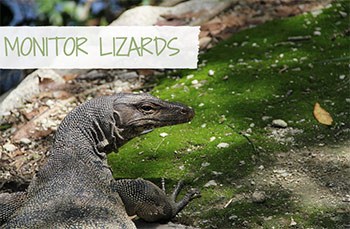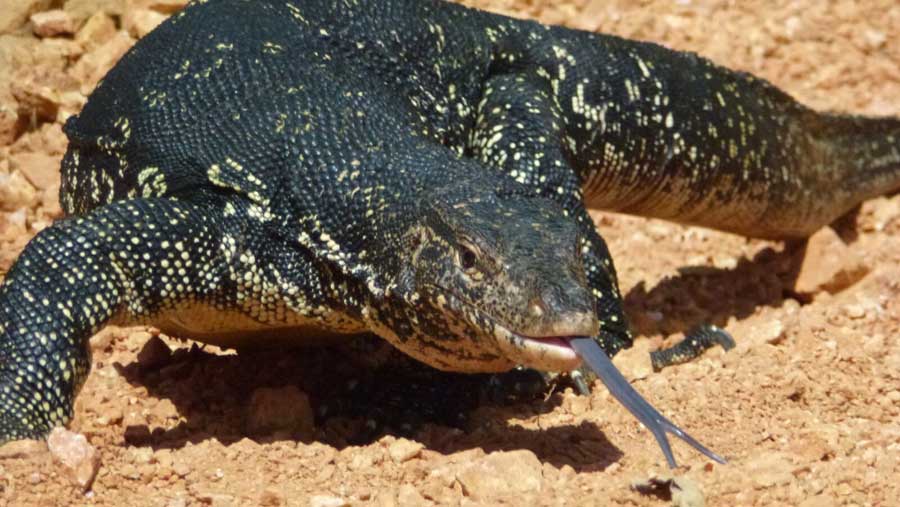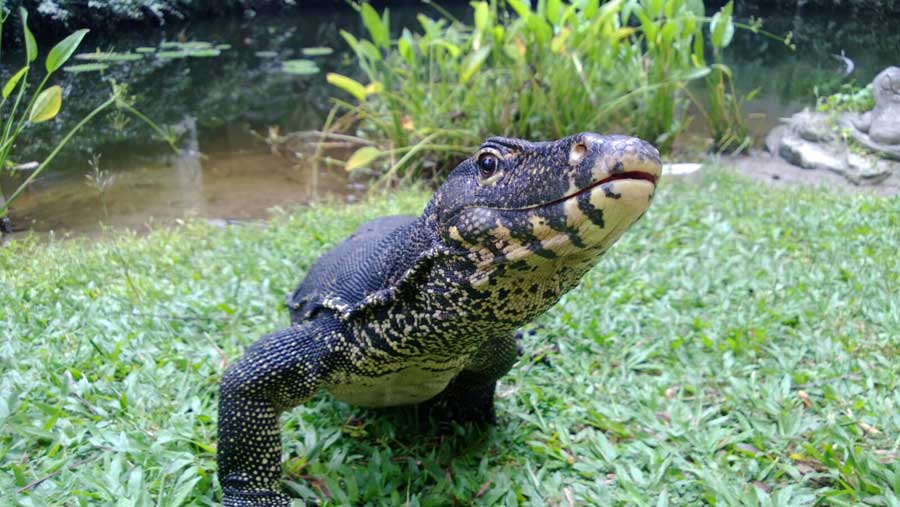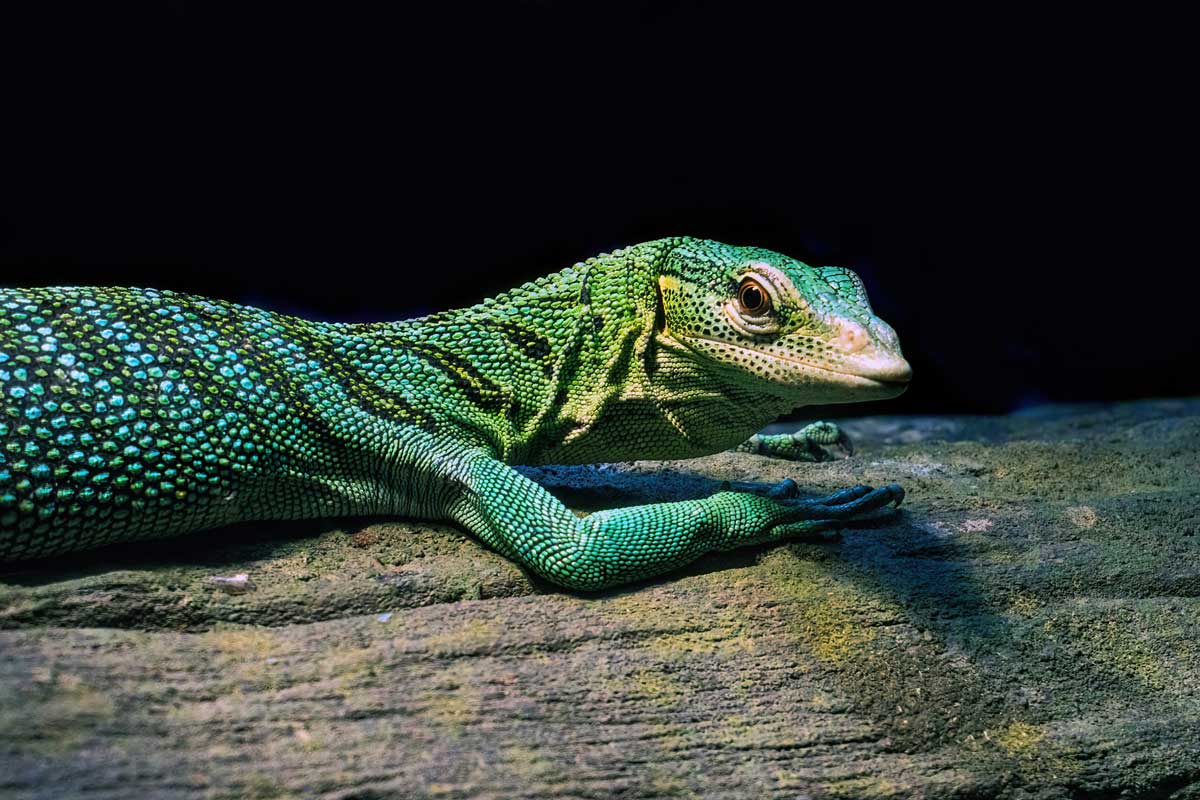All About Monitor Lizards

Dogs may be known as “man’s best friend,” but some people prefer a different kind of companion–one of a scalier variety. An interesting choice for a pet that is growing in popularity in the United States is the monitor lizard. The trend seems to have started in southwest Florida’s Cape Coral area, and from there, the monitor lizard population exploded and spread across the rest of the state. The lizards have even found homes in such densely populated areas as Orlando.
If you are curious about caring for, grooming, or feeding your lizard, we have everything you ever wanted to know and all your questions answered below. Read on to learn more about these quiet creatures, including facts about monitor lizards.
Physical Traits

There are at least 50 known species of monitor lizards, and new ones are being discovered constantly. Some have been known to be as small as 8 inches, but most (such as the Nile monitor lizard that has become popular in Florida) can be quite large.
They have long necks and sturdy limbs. Their claws are very sharp, and their tails typically account for half of their body length. Most monitor lizards stick to the ground, but some prefer to make their homes in trees or near water. Almost all species of monitor lizards are carnivorous, though a few will eat fruit.
Monitor lizards differ from most other known species of lizards in that they have a high metabolism. This means they must be fed more often than other lizards. While they are called “lizards,” monitors are thought to be most closely related to snakes. They are considered rather intelligent and have even shown the ability to count as high as 6.
Why Does It Move?
Monitors move for various reasons.
- One is to search for food.
- The second is to find shelter from the heat or to sleep and find basking spots.
- The third is to run from predators.
- And the final is to search for mates.
Males are most active during mating season. However, their movement may be limited by temperature changes and the need to conserve water.
How Far Can A Monitor Lizard Move?
The daily distance traveled by a monitor lizard varies based on the season, its habitat, and its size. Males tend to be more active than females, primarily because they eat more food (and thus have more energy) and grow faster. Some monitor species spend most of their time in one location, while others are constantly in motion.
Monitor lizards have sharp and sensitive eyesight. They can see objects from far away and use this advantage to identify prey and keep their distance from predators. Their eyesight, similar to certain types of dinosaur (Tyrannosaurus) is based on movement. Their visual field spans 240 degrees.
Read Our Reptile Terrarium Reviews
Does It See In Color Or Black And White?
Just like researchers are uncertain about dinosaurs’ vision capabilities in terms of color, scientists are uncertain, at the time of this writing, whether monitor lizards can see in color or not. We do know that their ability to see in the dark is limited.
How Does It Communicate? Can It Hear?
The primary method of communication for monitors is via their movements and posture. They will make various noises – hissing when threatened and, at times, a sneezing-like sound. Evidence suggests that monitor lizards can hear, but as far as researchers can tell, they rely less on hearing and more on their other senses
What Does It Eat?
Some monitor lizards have sharper teeth than others. But teeth don’t necessarily make a difference, as monitor lizards will typically swallow their prey whole. The epiglottis prevents food and water from entering the larynx, allowing a monitor lizard to breathe while eating food. Unlike human teeth, a monitor lizard’s teeth are replaced regularly throughout their life.
Does A Monitor Lizard Retain Water?

While monitor lizards can retain water reasonably well, their overall ability depends on their environment. Shifts in temperature and climate will also affect a lizard’s ability to retain water. Monitors that live near areas of water and don’t find the need to retain water as often have more difficulty retaining water in dryer environments.
In contrast, those who live near dryer areas have a greater ability to retain water. Monitor lizards living in tropical, humid climates are better able to retain water as the air itself contains more water. Smaller animals living in dry areas that can hide in burrows and trees are more successful at retaining water than their larger counterparts, which have more difficulty escaping the dry, arid heat.
How Does It Track Scents?
Monitor lizards’ fork-like tongues, allowing them to taste the air and detect movement and prey. Taste buds on their tongues and organs near the tip of their nose allow them to almost triangulate the location of a smell, depending on which side of the tongue they are locating a scent. Water monitors also use their tongues to test their prey before consuming it. They can use these techniques both underground and underwater.
How Do Males And Females Distinguish Themselves From One Another?
It is hard to distinguish a male monitor from a female one based purely on physical appearance. Monitor lizards can identify other males and females with their sense of smell. The lizards release pheromones and mark their territory in a similar fashion to other animals (dogs, for example—by urinating).
Monitors can drag their tails to mark their territories and will use these markings to protect their territory—in particular, food, shelter, and basking areas. They will also mark one another by tasting each other’s heads, shoulders, and pelvic girdles.
How Large Does It Grow?
The size of a monitor lizard varies entirely according to its species. Some have long necks and snouts, and some short; some have long necks, and others barely have one at all. Their bodies also vary greatly in size. The largest living monitor lizard is the famous Komodo dragon, which can be found on several islands, including one named after the lizard itself—Komodo Island, in Indonesia.
Various factors contribute to monitor lizards’ size, including diet and nutrition, climate, and habitat conditions. In general, male lizards are larger than female lizards.
Does It Like To Be Petted?
This all depends on how domesticated they are. If born in captivity or if a baby monitor lizard is adopted when young, they are easier to tame. Regular human contact will help them grow on you. They typically enjoy being scratched under their chin, on their back, behind their ears, and on top of their head—just behind their eyes. If they start inflating their throats and hissing, you’re doing something wrong. If they breathe deeply, then they’re enjoying what you’re doing.
Are Monitor Lizards Dangerous?
Most of us have known a small reptile owner who has kept a frog, turtle, or even an iguana as a pet. Some may even consider these pets to be cute or intriguing, but the fact is that monitor lizards are not that easily domesticated, and they can be dangerous when forced to live in a human environment. While most pet lizards are small and can be kept in a small glass aquarium, monitor lizards can grow to humongous sizes, up to over 7 feet long. Not only can these animals grow relatively large, depending on species, but they can be rather ferocious, to the point where some experts claim they are impossible to domesticate or tame.
While these intelligent, large creatures have become quite popular in the reptile pet trade, owning them has inherent dangers, and they are not suited for the beginner reptile owner. Many would recommend that no one should own one as a pet. As you will see, there are many dangers to owning a monitor lizard. If you are looking for companionship in a pet, a dog or cat may be a better alternative because bonding with human beings is not generally in the monitor’s repertoire of characteristics.

Photo by David Clode. Licensed via Unsplash.
Taking Care Of Your Monitor Lizard
Unlike your standard household pet, monitor lizards don’t need to be groomed. Their skin falls off itself, just like you’ll see with other reptile skins, including snakes. You must furnish your water monitor cage with materials that will keep the nails trimmed.
Unlike dogs and cats, monitors do not require grooming. The right furnishings prevent the nails from overgrowing, and dead skins come off themselves due to the right furnishings and humidity. For breeding purposes, it is best if the animals are not handled and left to their privacy. Monitors display their superiority by rubbing their backs or lying on top of them. In holding these animals, one finds their skin to be warm and dry rather than wet and slimy.
Monitoring Its Hygiene
Excuse the pun. An essential part of grooming your monitor lizard involves checking it for parasites. This isn’t something to worry about as long as they are treated. When you first obtain your water monitor, or if you haven’t done so already, take it to the vet to be examined. The vet will be able to kill the parasites with medications. In general, if you ensure that your lizard’s cage is kept clean and the lizard stays well nurtured, taken care of, and well-fed and groomed (as described above), you will help prevent a parasite infestation from recurring.
How Does It Defend Itself?
Monitors are well adapted to their environment and well camouflaged, which helps them avoid potential predators. Snakes are considered to be the monitor lizard’s most feared predator. Young monitor lizards can rely on color and behavior for defense—they are more spread out than adults, and they can take cover more quickly and effectively.
Larger Lizards Defend Themselves In Different Ways Than Smaller Lizards
Larger lizard species, with fewer predators on their tails, will lie out in the open and cease moving when they spot a predator. However, if the predator comes close, it’ll take off in the opposite direction of its advance. An adult monitor lizard can go faster than the average human and most other lizards. Once they can, they will hide in burrows, trees, or even underwater.
What Are Its Defense Mechanisms?
When confronted, monitor lizards try to puff themselves up as much as possible, making themselves appear larger and more threatening. They stand upright on all fours, puffing up their lungs, flattening their back, making a hissing sound, and some will also sway from side to side. As a final protective measure, they open their mouths as far as they can.
But will a monitor lizard attack if confronted? Yes! If approached, the monitor lizard may lunge and attack. In this sense, it is much like a momma Lion whose babies are threatened: It will attack relentlessly.
It’s Aggressive Nature
When listing the dangers of keeping a certain animal as a pet, the physical dangers of the animal (such as its teeth or claws) are the obvious considerations. However, the most dangerous trait the monitor lizard possesses may be its aggressive and extremely ferocious personality. The monitor lizard cannot be tamed and knows no loyalty to its owner.
While the pit bull may often show aggression toward strangers or anything it deems a threat to its human companion, the monitor lizard feels no such allegiance and will violently turn on its owner just as easily as it would on any prey or outside threat it senses. It would be unwise to underestimate the physical danger this lizard poses to anyone it comes in contact with, as it is rather strong and supremely quick. That and the creature’s naturally aggressive tendencies must be considered before a monitor lizard is taken in as a pet.
Does It Bite?
You might be wondering, can lizards bite? Yes. But, while the lizard teeth of the monitor lizard are small, they are pretty sharp. Therefore, monitor lizard owners must be constantly wary of their pet’s tendency to lash out and attempt to take a chunk out of them whenever the opportunity arises.
As one monitor lizard owner relates:
Nile monitors are one of the most aggressive lizards found in the pet trade and do not make good pets unless you are a very experienced lizard keeper. I have a 5 ½-foot female Nile, which I like, but I don’t recommend them for most people. They are almost impossible to tame and will not hesitate to give you a very bad bite. I have had mine for over 5 years, and it still attempts to attack me every chance it gets. Savanna monitors are much easier, but no monitors are considered beginner lizards.
Video: Monitor Lizard vs Croc
Watch this two-minute video to see the monitor lizard and its aggressive behavior as it goes after a crocodile’s eggs.
Is It Venemous?
Many monitor lizard owners share similar experiences with their exotic scaly pets, and Nile monitors, in particular, will not hesitate to attempt to bite their caregivers. There is no denying that a bite from any species of monitor lizard can be downright painful, as monitors have been known to crush bones in humans.
Beyond the danger to the skin, bone, and surrounding tissue, monitor lizard bites are also venomous, resulting in swelling and excessive bleeding. Experts initially presumed that meat and other bits of food stuck between the lizard’s teeth carried dangerous strains of bacteria, causing such a reaction in those who were bitten; however, it was discovered a few years ago that this reaction is the result of venom that is unleashed when the lizard bites. This venom is not fatal to humans but can cause illness and pain.
The danger in a monitor lizard’s venomous bite is for small animals or infants. The venom stops blood from clotting, causes a rapid drop in blood pressure, and heightens the pain associated with the bite. Researchers have even found that monitor lizard venom contains Crotamine, the same poison in rattlesnake venom. Though it should be noted that it is present in such small amounts that it is not fatal to humans, it is still a sobering thought. The monitor lizard’s venom acts as a sort of knockout punch to small mammals and birds, so if you have a small child or a cat, dog, or other pet, it would be unwise for you to adopt a monitor lizard.
Tail And Claws
The monitor lizard has other weapons to go along with its venomous razor-sharp bite. On each of its paws are sharp claws used to grab and rip into its prey. While the risk of being sliced up by the monitor lizard is scary enough, its tail may be its most formidable weapon. The lizard’s tail is very muscular and can badly injure a person. If you are looking for a pet you can play around with or show off to your friends; the monitor lizard is a poor choice.
As one monitor lizard owner relates:
Monitors are NOT tame, and if you are lucky, you may be able to take your monitor out of the cage, but if you try to hold it, you will probably get bit[ten] or tail whipped. That [tail whip] can break your hand or take off fingers.
The monitor lizard’s tail can account for more than half of the body’s total length, and the lizard is naturally disposed to use this formidable weapon with whip-like action. When confronted or even mildly agitated, the monitor will whip around with its muscular tail to incapacitate its prey or any perceived enemy. When it decides to turn that tail on its human owner, it becomes a dangerous pet to own.
This natural weapon makes it easy to see why this lizard is not recommended as a pet in general and why even the most experienced reptile enthusiasts must be careful around such a powerful creature. For this reason, it is of utmost importance that the lizards are kept far away from other pets and small children.
The Diseases It Carries
As we’ve already established, if you have small children or are planning to, a monitor lizard is not a wise pet choice for various reasons, but there are other considerations. Most people are aware of salmonella, a disease that can make you very, very sick. Salmonella is a broad term encompassing over 2,000 different kinds of disease-causing bacteria. You may think of it as something caused by bad food or an unhygienic lifestyle, but while this is true, reptiles (and other animals) are also major carriers of the disease. Monitor lizards, in particular, have been linked to a specific strain of salmonella.
Several years ago, the Centers for Disease Control (CDC) identified a rare strain of salmonella called S. poano in the stool of an infant. A couple of months before this discovery, a baby was brought to the hospital to be treated for bloody diarrhea, flatulence, and a temperature of 101 degrees. A stool sample was taken, and S. Poano was found. The baby was treated with antibiotics and fully recovered, but the doctors were baffled as to the original cause of the salmonella. The parents did not have the disease, and though the child attended a daycare center three times a week, none of the other students were symptomatic.
The doctors performed a home examination and found that the only pet living in the house when the child became sick was a python. Doctors examined the snake and found no S. Poano present in it or its habitat. However, it was later discovered that the family had been housing a 2-foot monitor lizard a month before the child became sick. The parents had returned the lizard to the pet store in exchange for the snake because the lizard suffered from chronic diarrhea.
Stool samples taken from the lizard revealed it to be the culprit. Though the baby was never allowed near the lizard and only the father cleaned the cage, the salmonella the lizard carried was still transferred to the infant. This was possible because of the method of cleaning the cage. The cage was about waist-high on the father, and he had to step into the cage to clean it. He did so in his bare feet, and when he stepped back out of the cage, he unwittingly tracked the disease throughout the house.
Another possibility was that the baby contracted the disease via the heat rocks, which the father cleaned in the kitchen sink and possibly caused contamination in an area where the family prepared food. S. Peano was first discovered in Ghana, and during this infant’s difficulties with it, the only other reported cases of human infection with that particular bacterial infection stemmed from human contact with Savannah monitor lizards.
As dangerous as it is, S. poano is not the only bacteria that monitor lizards carry. Importing monitors from places like Ghana is not carefully regulated, so there is no way to ensure that the lizard you select as a pet is not a carrier of any disease. In most cases, the lizards show no signs of disease, but it is estimated that 90 percent of all reptiles are salmonella carriers. This is another serious danger of owning a monitor lizard, as it is estimated that up to 4 million cases of salmonella are contracted each year, resulting in 500 annual deaths.
Overpopulation And Other Dangers
In Florida, the Nile monitor lizard population is growing steadily. Despite efforts to control the population growth of the animals by trapping and relocating the creatures to more suitable environments, their presence in the state continues to grow at an alarming rate. This may not seem to be a pet owner’s problem, but it is a direct result of carelessness on the part of monitor lizard owners, and it is a danger to society, mainly because the Nile monitor is one of the largest and most potent species of monitor.
The problem with owning a monitor lizard as a pet often stems from the motives behind it. People often adopt “unique” or “exotic” animals on a whim, assuming it will be something they can talk about or show off to their friends. Indeed, owning such an animal is a conversation starter. However, the problem with this impulsive attitude toward owning such a dangerous animal (or any animal) is that prospective owners do not take the time to make themselves aware of the responsibility involved. When purchasing a monitor lizard, many people do not realize how large the creature may grow to be, mainly because they are so small when first adopted. The lizards grow incredibly fast; a Savannah monitor has been known to grow from 7 to 44 inches in one year, requiring an 8’x4′ cage, and Nile monitors require double that amount of space.
Monitor lizards are also much more challenging to care for than other reptiles. Because of their high metabolism, they must be fed more often than other reptiles. This can be quite cost-prohibitive, as the smaller monitor lizards may eat more than $40 worth of food daily, and larger monitor lizards eat much more. Whether it is because prospective monitor lizard owners fail to do the necessary research or because the vendors selling the lizards fail to inform prospective buyers, most people who purchase monitor lizards are unaware of these important facts and of the responsibilities that owning a monitor will entail.
Because new monitor owners are unaware of the dangers and responsibilities, they are often caught off guard once the animal begins to grow and behave naturally, and they look for a quick way to get rid of the animal. Sadly, the lizards are abandoned in local natural areas. This causes many problems for local wildlife, as the monitor lizard is very fertile, and its presence disrupts the delicate balance of specific ecosystems.
Experts claim that the monitor lizard is a tremendously fertile breeder. Females are known to lay up to 30 eggs at a time, once or twice per year. The Nile monitor lizard is a ferocious carnivore and has become a significant threat to many of Florida’s endangered species, including the endangered ground owl and the gopher tortoise. Because the Nile monitors lizards’ appetite for eggs, it threatens alligators and the American crocodile population, as their ground nests make easy targets for the lizard.
Due to all of these factors, the monitor lizard has become a threat not only to its human owners but also to the natural world in which it is abandoned. It is a danger to all who live in the regions where these lizards are being imported, not only to the natural wildlife that inhabits these areas but also to the innocent pets, children, and even adults who call these places home.
Considering A Monitor Lizard As A Pet?
If you consider owning a monitor lizard as a pet, you must be aware of the dangers. There is a risk to your health and the physical well-being of all other people and animals who live in your home and your area. It is not illegal to own a monitor lizard in most states, though many require a permit to do so, so you are cautioned to pay attention to the safety concerns here and the laws in your region. If you adopt a monitor lizard, be sure you are prepared to exercise extreme caution and are willing to keep and care for the animal for its life, which can last up to 10 years.
Learn about other types of lizards or dig more into the water monitor. Did you know that the water monitor is also known by its Latin root, Varanus Salvator. One of the largest lizards in the world, it can grow to nine feet and reach a weight of one hundred pounds! It is outsized by only two other lizards: the Komodo dragon and the crocodile monitor. The Komodo can gain more weight than the water monitor, while the crocodile can grow longer—up to twelve feet!
Do you own or have you ever seen a monitor lizard? Let me know in the comments!




